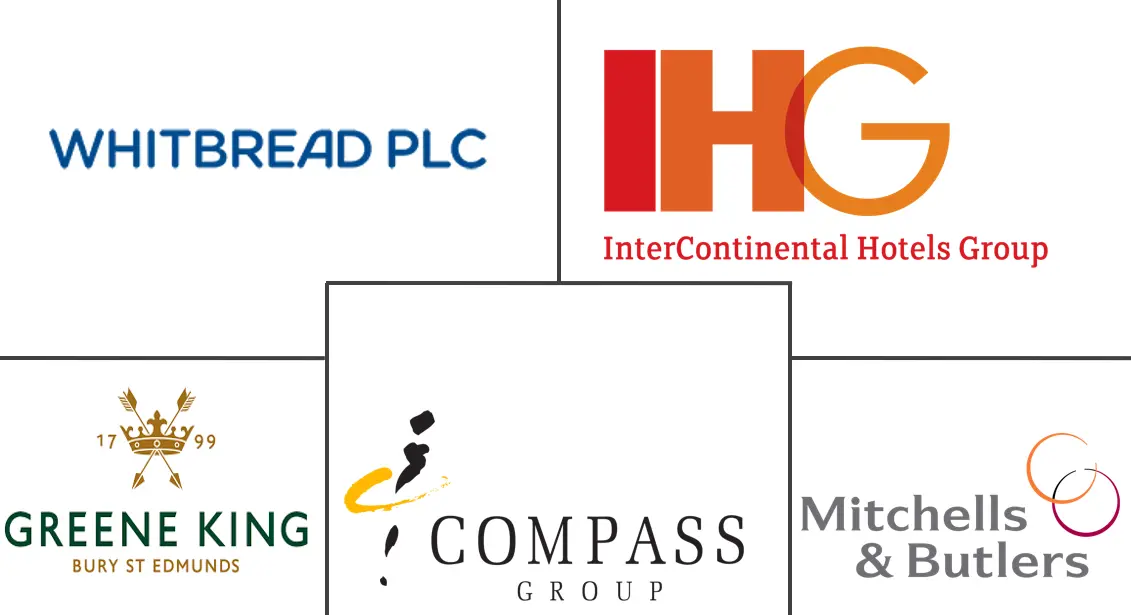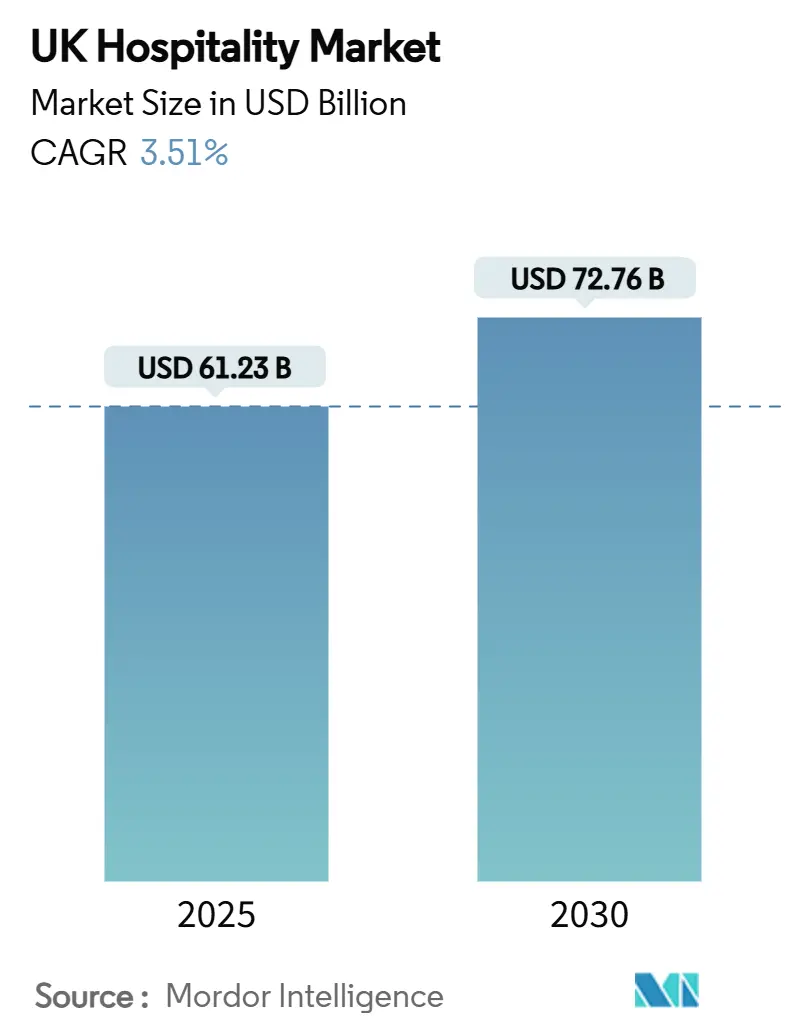
UK Hospitality Market Analysis by Mordor Intelligence
The UK hospitality market is valued at USD 61.23 billion in 2025 and is forecast to reach USD 72.76 billion by 2030, expanding at a 3.51% CAGR. Rising inbound tourism on the weaker pound, rapid uptake of digital ordering systems, and the outsourcing boom in institutional catering underpin the sector’s steady advance. Operators that combine technology with flexible service models are winning share, even as labor shortages, energy cost volatility, and tighter business-rate relief squeeze margins. Consolidation is gathering pace as chains deploy scale advantages in procurement and data analytics, while independents respond with experiential concepts attuned to local demand. The result is a dynamic yet uneven recovery in which the UK hospitality market continues to reinvent itself around value-conscious consumers and hybrid work lifestyles.
Key Report Takeaways
- By sector, restaurants and foodservice led with 52.41% revenue share in 2024 in the UK hospitality market, whereas contract catering is forecast to grow at a 5.96% CAGR to 2030.
- By service model, quick-service operations captured 37.85% of the UK hospitality market in 2024; contract and outsourced services record the fastest projected CAGR at 5.96% through 2030.
- By end-user, domestic tourists accounted for 55.44% share of the UK hospitality market size in 2024, while education and health institutions are advancing at a 5.71% CAGR to 2030.
- By booking channel, direct bookings held a 34.62% share in 2024; online travel agencies are set to rise at a 5.25% CAGR through 2030.
- By geography, England contributed 74.22% of activity in 2024, while Northern Ireland is poised for the strongest growth at a 6.19% CAGR over the forecast period.
- The market is highly fragmented, with still top 5 players, such as Whitbread PLC (Premier Inn), InterContinental Hotels Group (IHG), Compass Group PLC, Compass Group PLC, Greene King, Mitchells & Butlers holds major market share in 2024.
UK Hospitality Market Trends and Insights
Drivers Impact Analysis
| Driver | (~) % Impact on CAGR Forecast | Geographic Relevance | Impact Timeline |
|---|---|---|---|
| Accelerating digital ordering and booking | +0.8% | England and Scotland core, Wales emerging | Short term (≤ 2 years) |
| Government VAT relief and incentive schemes | +0.6% | England, Scotland, Wales, Northern Ireland | Medium term (2-4 years) |
| Rising inbound tourism on weak GBP | +0.7% | England dominant, Scotland secondary | Medium term (2-4 years) |
| Hybrid-work-fuelled mid-week leisure stays | +0.5% | England urban centers, Scotland cities | Long term (≥ 4 years) |
| Outsourcing surge in institutional catering | +0.9% | England and Scotland core, Wales growth | Long term (≥ 4 years) |
| Source: Mordor Intelligence | |||
Accelerating Digital Ordering and Booking
QR-code menus, pay-at-table apps, and frictionless wallets have moved from pandemic stopgaps to mainstream tools that lift table-turn times and customer satisfaction. Eighty percent of diners now choose QR payments when provided the option, driving higher throughput at peak periods. Contactless transactions already represent 27% of all UK payments, and digital wallets are on track to account for 39.7% of retail and hospitality spend by 2032[1]Source: UK Finance, “UK Payments Markets Summary 2025,” ukfinance.org.uk. Venues that invested early are reporting stronger repeat-visit rates as loyalty data fuels personalized offers. With 32% of UK adults enrolled in mobile payment apps, the foundation is set for granular yield management that rewards off-peak visits and captures incremental spend.
Government VAT Relief and Incentive Schemes
For 2025/26, the Retail, Hospitality and Leisure Relief scheme grants 40% business-rate relief, capped at GBP 110,000 per property (USD 148457.06), delivering GBP 1.5 billion (USD 4.59 billion) in support[2]Source: HM Treasury, “Autumn Statement 2024—Business Rates Factsheet,” gov.uk. The extension of alcohol-duty freezes and a higher VAT registration threshold complement this relief, offsetting part of the GBP 3.4 billion annual hit from higher National Insurance contributions. Policymakers view hospitality as the third-largest private employer, underpinning 2.9 million jobs, so targeted incentives are calibrated to preserve capacity while maintaining fiscal discipline.
Rising Inbound Tourism on Weak GBP
VisitBritain projects 43.4 million international visits in 2025, worth GBP 33.7 billion (USD 45.48 billion) —up 7% on 2024—as the weaker pound boosts spending power for US, EU, and Asian travelers. While the UK ranks poorly on price competitiveness due to VAT and aviation taxes, currency effects partially offset cost perceptions and open space for premium positioning. Operators tailoring packages to US visitors, expected to spend GBP 6.7 billion (USD 9.04 billion), are capturing high-margin demand for heritage, dining, and sports events.
Hybrid-Work-Fueled Mid-Week Leisure Stays
Sixty-six percent of UK travelers now merge business and leisure in one trip, compared with 53% in 2022. Hotels have responded by upgrading bandwidth, creating co-working lounges, and bundling wellness services. Dynamic mid-week pricing lifts RevPAR without eroding weekend yields, turning erstwhile slow days into profitable micro-seasons. Properties that align room inventory and F&B offerings to this blended segment are seeing improved average-length-of-stay metrics.
Outsourcing Surge in Institutional Catering
Only half of potential UK institutional food operations are currently outsourced, giving players like Compass Group ample runway; the company delivered 10.3% organic revenue growth in 2024. Hospitals, universities, and defence sites are pivoting to specialist caterers that promise compliance, sustainability, and menu innovation. Long-term contracts insulate revenue streams, making this sub-sector a stabilizing force within the broader UK hospitality market.
Restraints Impact Analysis
| Restraint | (~) % Impact on CAGR Forecast | Geographic Relevance | Impact Timeline |
|---|---|---|---|
| Acute labor shortages and wage inflation | -1.2% | England and Scotland core, Wales emerging | Long term (≥ 4 years) |
| Food and energy cost volatility | -0.9% | England, Scotland, Wales, Northern Ireland | Medium term (2-4 years) |
| Stringent planning / licensing rules | -0.4% | England regulatory focus, Scotland variations | Medium term (2-4 years) |
| High reservation no-show rates | -0.3% | England urban centers, Scotland cities | Short term (≤ 2 years) |
| Source: Mordor Intelligence | |||
Acute Labor Shortages and Wage Inflation
The sector carries 121,000 open positions and a 52% annual turnover, figures that sit 48% above pre-COVID levels. Brexit-driven visa rules raised the skilled-worker salary floor to GBP 38,700 (USD 52229.89), well beyond average front-of-house wages, prompting operators to trim trading hours or cap covers. National Insurance hikes add costs of GBP 3.4 billion (USD 4.59 billion), undermining already thin margins. While automation and self-service technology offset some pressure, guest-facing roles resist full substitution, making talent retention central to growth.
Food and energy cost volatility
Hospitality businesses across the UK are facing escalating challenges due to unpredictable spikes in both food and energy costs, which erode tight profit margins. Food price inflation climbed as high as 19% during 2022–23 for key ingredients like dairy, meat, and produce, and although it has eased slightly, it remains elevated at 4–6% in early 2025. These fluctuations stem from global supply chain disruptions, extreme weather conditions that affect harvests, higher labour and packaging expenses, and post-Brexit import complexities. Meanwhile, energy costs have effectively doubled since 2019 for many venues, now accounting for around 5–10% of annual revenues in pubs, restaurants, and hotels. In this context, nearly 60% of food and drink operators report energy as their top concern, often reducing operating hours or closing parts of their service just to manage utility bills. The combined impact of food and energy cost volatility places operators in a bind: passing increased costs to consumers risks suppressing demand in an already squeezed market, yet absorbing those costs further tightens margins. This dynamic not only dampens investment and growth in the sector but also poses an existential threat to smaller hospitality venues trying to remain viable in a fragile economic climate.
Segment Analysis
By Sector: Foodservice Dominance Drives Innovation
Restaurants and foodservice providers retained the lion’s share, contributing 52.41% to the UK hospitality market in 2024. Despite macroeconomic headwinds, experiential dining keeps footfall robust as consumers seek social engagement outside the home. Quick-service chains, armed with kiosk ordering and kitchen automation, sustain margins, whereas full-service venues wrestle with wage inflation. Nearly 2,000 full-service restaurants shuttered in 2023 as utilities and staffing costs spiked. In parallel, contract catering’s 5.96% CAGR signals that institutional clients value outsourced expertise over in-house canteens.
A surge in blended travel is breathing mid-week life into pubs and bars, with operators like JD Wetherspoon reporting an eightfold jump in pre-tax profit to GBP 36 million. Leisure-entertainment venues, from live-music halls to esports arenas, are monetizing dynamic pricing for peak events. The UK hospitality market size for contract catering is projected to expand to 5.66% CAGR, making it a stabilizing counterweight to more cyclical F&B segments.
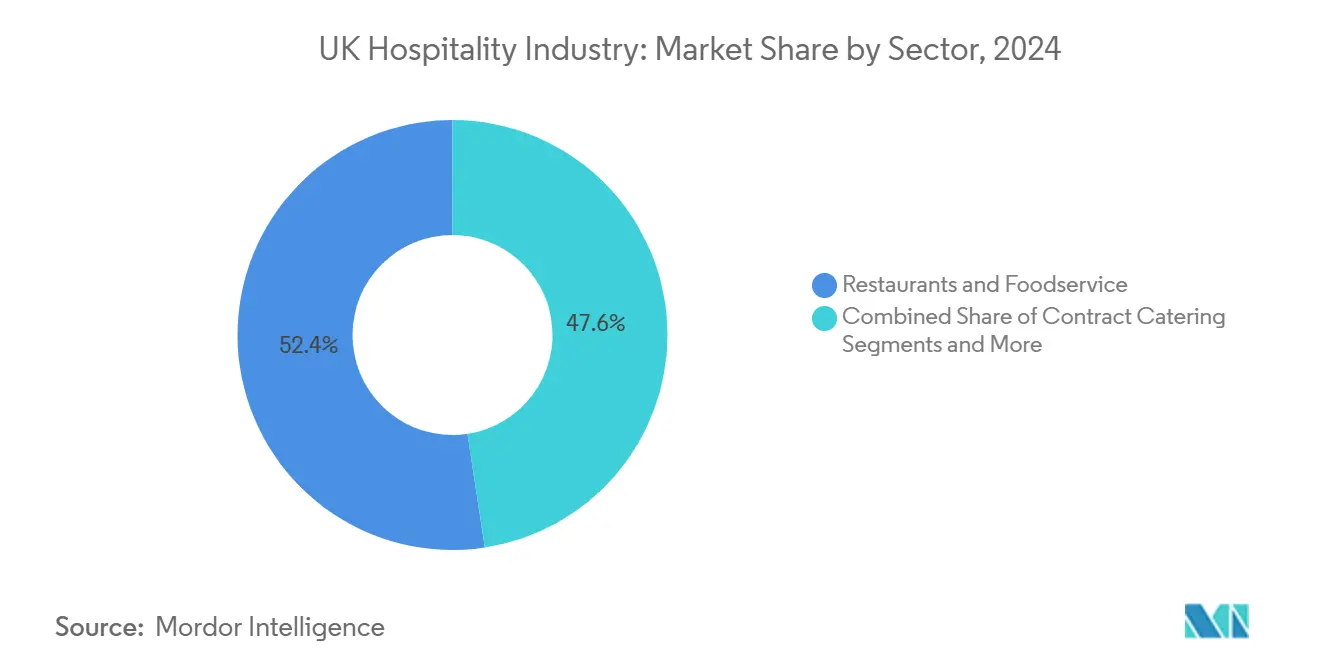
Note: Segment shares of all individual segments available upon report purchase
By Service Model: Quick-Service Efficiency Gains
Quick-service and grab-and-go formats represented 37.85% of the UK hospitality market in 2024 and thrive on throughput and cost control. Chain algorithms fine-tune labor scheduling and ingredient purchasing, mitigating wage and food inflation. In contrast, full-service formats rely on ambience and service to justify price premiums; those unable to deliver distinct experiences face erosion. Contract and outsourced services, although smaller in absolute terms, are growing fastest at 5.96% CAGR as public institutions pursue value for money.
Limited-service hotels such as Premier Inn are adding rooms by converting underused restaurant footprints, blending lodging with streamlined F&B. QR ordering and smartphone check-in lower staffing demands, feeding an efficiency loop. Segment leaders harness centralized purchasing and dynamic pricing, reinforcing economies of scale. The UK hospitality market share for quick-service formats will likely widen if labor costs continue to climb.
By End-User: Institutional Growth Accelerates
Domestic leisure travelers still represent 55.44% of guest volumes thanks to carry-over staycation habits and favorable currency differentials. International visitors, though fewer in number, spend more per trip—US tourists alone are expected to inject GBP 6.7 billion in 2025. Education and healthcare institutions are the fastest-growing slice, with a 5.71% CAGR as schools and hospitals pivot toward professional catering to meet dietary, safety, and cost mandates. The UK hospitality industry is thus diversifying away from pure leisure dependence on annuity-style institutional contracts.
Business event demand is rebounding. UK MICE enquiries jumped 22% year-on-year in 2024. Hybrid conferencing packages that integrate on-site F&B with virtual platforms are unlocking new revenue streams. Operators capable of serving multiple end-user cohorts within a single asset—such as a city-center hotel hosting conferences mid-week and leisure guests at weekends—enjoy stronger asset utilization.
By Booking Channel: Digital Transformation Accelerates
Direct digital channels claimed 34.62% of bookings in 2024 as hoteliers intensified loyalty programmes to curb OTA commission leakage. Nevertheless, OTAs are set for 5.25% CAGR, buoyed by mobile adoption and meta-search convenience. The UK hospitality market is witnessing the rise of AI-driven recommendation engines that personalize bundles, from add-on breakfasts to late-checkout upsells, boosting ancillary revenue.
No-show mitigation remains front of mind. Card authentication, small deposits, and reward-tier perks for honored reservations are becoming the norm. Forward-thinking operators unify POS and booking data, enabling predictive staffing and ingredient ordering that trims waste.
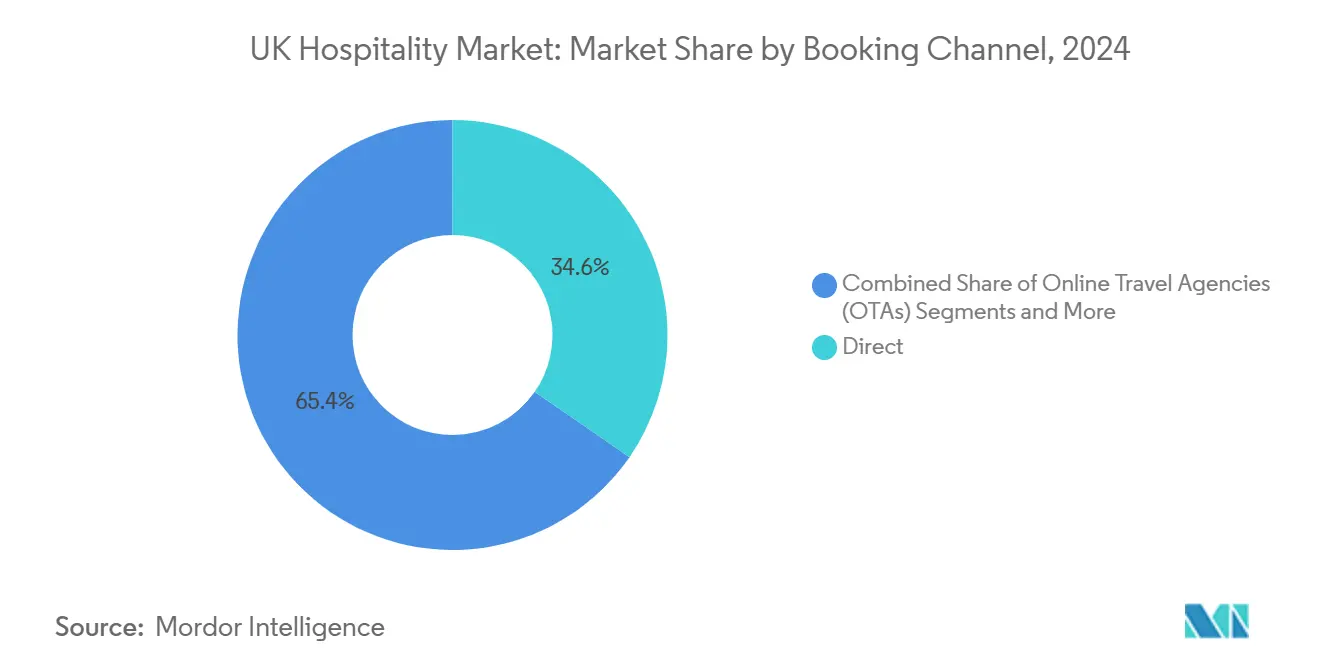
Note: Segment shares of all individual segments available upon report purchase
By Ownership Model: Consolidation Pressures Mount
Independents control 66.53% of sites but chains enjoy a 5.37% growth clip, propelled by Whitbread’s strategy of shifting capital toward high-yield rooms and away from low-margin restaurants. Franchising is the expansion vehicle of choice for pub operators JD Wetherspoon and Greene King, allowing footprint gains without ballooning balance sheets. Technology is the defining moat: branded systems cover procurement, CRM, and revenue management, while independents scramble to integrate piecemeal solutions.
The UK hospitality market size associated with chain assets is set to grow faster than the independent pool, yet curated local experiences keep community venues relevant. Some independents adopt mini-chain models, replicating a winning formula across two or three neighbourhood sites while preserving individuality.
Geography Analysis
England retains primacy, generating 74.22% of the UK hospitality market in 2024. London’s occupancy reached 82%, driven by a rebound in corporate travel and blockbuster events, whereas regional cities like Manchester and Newcastle grew faster in percentage terms on a smaller base. Southern resort towns leverage outdoor and heritage assets but contend with higher operating costs that erode margins. Meanwhile, urban hubs in the Midlands benefit from government-backed regeneration schemes that stimulate business tourism.
Scotland’s hospitality ecosystem leverages whisky trails and festival-led city breaks. Edinburgh and Glasgow benefit from international air links, while rural Highlands properties exploit adventure-tourism demand. A proposed regional visa could alleviate acute staffing gaps, enabling operators to extend trading hours and tap latent demand. Sustainability branding—carbon-neutral lodges and locally sourced menus—commands price premiums among eco-conscious travelers.
Wales positions itself as a value alternative for English families, blending coastal scenery with activity-rich national parks. Northern Ireland outpaces all regions at a 6.19% CAGR to 2030, catalyzed by Belfast’s expanding conference center and a peace-dividend tourism narrative. Cross-border promotions with the Republic of Ireland further widen the catchment. The UK hospitality market share allocated to Northern Ireland remains modest but is rising on the back of infrastructure investment and improved air connectivity.
Competitive Landscape
The market is highly fragmented with the presence of various market players in the industry. Whitbread lifted profit 36% in 2024 while trimming 1,500 roles via automation and asset recycling[3]Source: Whitbread PLC, “Annual Report and Accounts 2024,” whitbread.co.uk. IHG is retrofitting mid-scale brands with co-working lounges to harness blended travel demand, and Compass Group continues to snap up regional caterers to deepen sector penetration. Technology partnerships—such as Greene King’s adoption of an AI purchasing platform to forecast ingredient volumes—are spreading rapidly.
Strategic differentiation is clearest in F&B. Premium casual brands emphasize provenance and theatrical plating, defending price points even as cost-of-living concerns rise. Value chains focus on scale: centralized kitchens, high-volume SKUs, and limited menus strip complexity. Delivery aggregators pose both risk and opportunity; dine-in operators that co-operate with ghost kitchens achieve incremental sales without congesting front-of-house.
Innovation is speeding up. Dynamic price engines now synchronize room rates with restaurant menus, optimizing spend per guest stay. Energy-efficient refurbishments financed through green bonds lower utilities bills while enhancing ESG credentials. Over the forecast horizon, the UK hospitality industry is expected to see more vertical integration, such as food wholesalers acquiring casual-dining groups to anchor product flow.
UK Hospitality Industry Leaders
-
Whitbread PLC
-
InterContinental Hotels Group (IHG)
-
Compass Group PLC
-
Greene King
-
Mitchells & Butlers
- *Disclaimer: Major Players sorted in no particular order
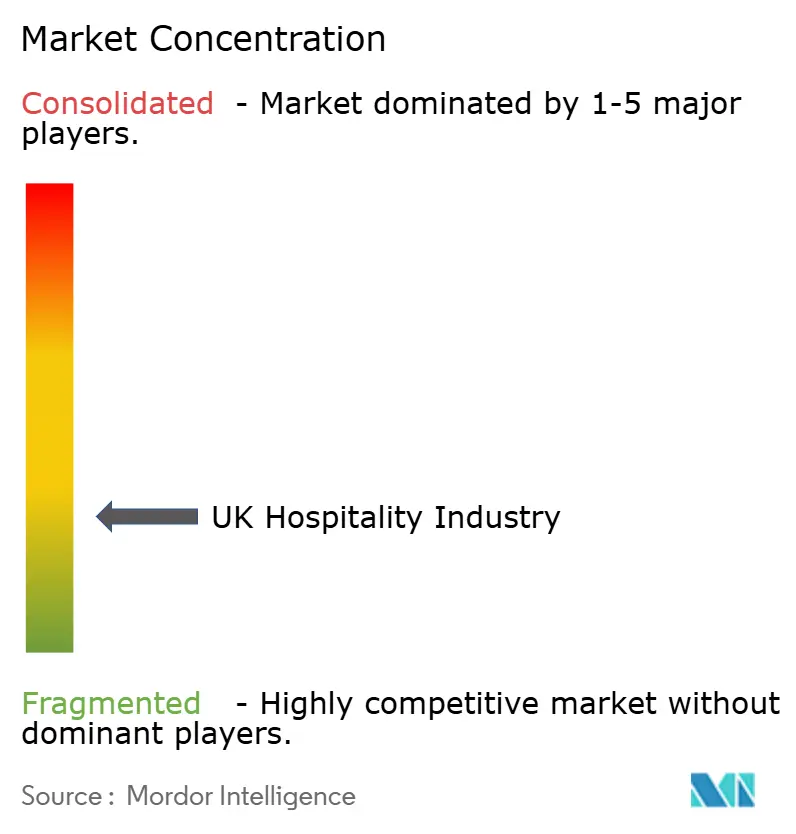
Recent Industry Developments
- June 2025: Premier Inn expanded its Ireland pipeline to 5,000 rooms, a 30% uplift versus prior targets.
- April 2025: JD Wetherspoon launched a franchise programme aiming for 1,000 UK sites in partnership with Christie & Co.
- April 2025: Greene King completed a GBP 40 million brewery upgrade to lift capacity and efficiency.
UK Hospitality Market Report Scope
The hospitality industry includes businesses that provide services to guests and travelers. This sector includes lodging (hotels and resorts), food and beverage services, event planning, theme parks, transportation, and other related services. The hospitality industry in the United Kingdom is segmented by type and segment. By type, the market is segmented into chain hotels and independent hotels. By segment, the market is segmented into luxury hotels, mid and upper-mid-scale hotels, budget and economy hotels, and service apartments. The report offers market sizing and forecasts in value (USD) for all the above segments.
| Accommodation | Hotels |
| Hostels and Budget Lodging | |
| Serviced Apartments | |
| Food and Beverage Service Establishments | Full-service Restaurants |
| Quick-service and Fast-casual | |
| Cafes and Coffee Shops | |
| Pubs and Bars | |
| Contract Catering / Institutional Foodservice | |
| Leisure and Entertainment Venues |
| Full-service |
| Limited / Budget |
| Quick-service / Grab-and-go |
| Contract / Outsourced |
| Leisure Travellers |
| Business Travellers |
| Domestic Tourists |
| International Tourists |
| Institutional Clients (Education, Health) |
| Direct |
| Online Travel Agencies (OTAs) |
| Corporate Agreements |
| Tour Operators / Wholesalers |
| Independent Operators |
| Chain / Branded |
| England |
| Scotland |
| Wales |
| Northern Ireland |
| By Sector | Accommodation | Hotels |
| Hostels and Budget Lodging | ||
| Serviced Apartments | ||
| Food and Beverage Service Establishments | Full-service Restaurants | |
| Quick-service and Fast-casual | ||
| Cafes and Coffee Shops | ||
| Pubs and Bars | ||
| Contract Catering / Institutional Foodservice | ||
| Leisure and Entertainment Venues | ||
| By Service Model | Full-service | |
| Limited / Budget | ||
| Quick-service / Grab-and-go | ||
| Contract / Outsourced | ||
| By End-User | Leisure Travellers | |
| Business Travellers | ||
| Domestic Tourists | ||
| International Tourists | ||
| Institutional Clients (Education, Health) | ||
| By Booking Channel | Direct | |
| Online Travel Agencies (OTAs) | ||
| Corporate Agreements | ||
| Tour Operators / Wholesalers | ||
| By Ownership Model | Independent Operators | |
| Chain / Branded | ||
| By Geography Geography | England | |
| Scotland | ||
| Wales | ||
| Northern Ireland | ||
Key Questions Answered in the Report
What is the current size of the UK hospitality market?
The UK hospitality market size stands at USD 61.23 billion in 2025 and is projected to reach USD 72.76 billion by 2030.
Which sector holds the largest UK hospitality market share today?
Restaurants and general foodservice outlets hold the largest share at 52.41% in 2024.
Why is contract catering growing faster than other segments?
Public and private institutions are outsourcing dining operations to specialists to meet dietary standards, cut costs, and improve service, driving a 5.96% CAGR in contract catering revenue.
How are operators tackling labor shortages?
Firms are raising wages selectively, adopting QR-code ordering and kitchen automation, and lobbying for more flexible visa pathways to secure skilled staff.
What role does technology play in future growth?
Digital booking, mobile payments, and AI-driven revenue management improve efficiency and enhance customer experience, making technology adoption a core competitive lever across the UK hospitality industry.
Page last updated on:
